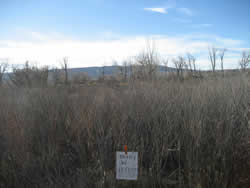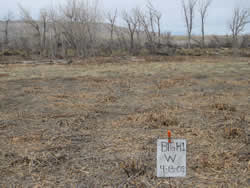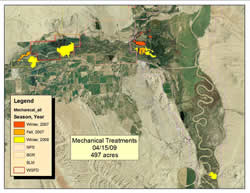
National Fire Plan Success Story
Interagency Effort Removes Hazardous Fuels, Improves Habitat
Big Horn Canyon National Recreation Area, Wyoming
National Fire Plan - Firefighting
2009
An aggressive mastication project at Big Horn Canyon National Recreation Area (NRA) not only significantly reduced hazardous fuel loading, but also improved habitat for pheasant, whitetail deer, turkeys and other wildlife.
Since the winter of 2007, nearly 500 acres around the Big Horn and Shoshone rivers have been treated by the Cooperative Resource Management (CRM) group, which consists of Wyoming Game and Fish, National Park Service, the Bureau of Reclamation, Bureau of Land Management, Park County Weed and Pest and several private landowners. The group works together to select projects and secure funding, some of which comes from the Wyoming Wildlife and Natural Resource Trust, andthen completes most of the mastication work through contractors.
An inmate crew began the project with chainsaws along a railroad, but the CRM realized the work was tedious and created abundant dead and down fuel. In 2007, CRM hired contractors with gyro-tracks to complete the fuels project. Most of the project work is done in the winter while the ground is frozen, lessening the impact to the soil and other vegetation. The gyro-track leaves behind a layer of mulch, rather than downed trees that need to be burned.
The largest project in the NRA is behind a large bentonite plant and along the railroad track. The approximately 100-acre project is surrounded by cottonwoods along a riparian area.
“The Russian olive trees were so thick in here that you couldn’t walk through this area, it was basically inaccessible,” said Cassity Bromley, acting chief of resources at Bighorn Canyon. “We were concerned about the fire hazard, but this area is also a popular pheasant hunting location. Hunters and their dogs couldn’t maneuver in here anymore. Now that we’ve opened it up by removing those trees, we’ll monitor it to make sure native species return.”
In April, an escaped ditch burn had the potential to threaten the park, but it burned into an area on private land that CRM had treated and firefighters were able to contain it
Another 20-acre project area targeted in Bighorn Canyon, further south along the Big Horn River, was overrun with tamarisk, another non-native, invasive species. CRM is planning to continue projects in the park and surrounding area to reduce fuels and improve habitat.
Contact: Cassity Bromley, Acting Chief of Resources, (307) 548-5416.


